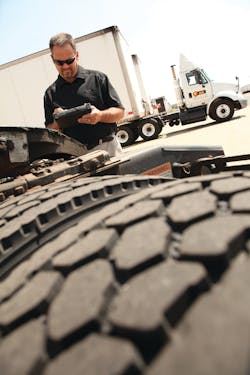Four ways to put the brakes on vehicle expense with proactive maintenance
One of the most disturbing and disruptive events that plagues drivers, dispatchers and fleet managers is a truck that unexpectedly breaks down, observes Tom Dorazio, senior product manager at PeopleNet, a leading provider of innovative and integrated onboard computing and mobile communications systems for effective fleet management (www.peoplenetonline.com). There are wide-reaching implications: driver productivity plummets, the delivery schedule crumbles, customer service suffers and the repair cost can be excessive.
More often than not, he says, unexpected costly breakdowns are the result of a reactive approach to maintenance. Fortunately, there are several ways a fleet can become more proactive.
1. FAULT CODES
First, engine data can turn onboard recorder data into an early warning system by driving fault code notification, says Dorazio. Exception alerting calls attention to potential mechanical issues that maintenance can nip in the bud before they turn a delivery schedule upside down.
Without this tool for preventive maintenance, diagnostics is delayed until the truck arrives at the shop or dealership, either on its own power or by a tow.
With fault code notification, maintenance personnel can determine how urgent an issue may be so they can schedule necessary repairs before the problems have a chance to squash drive time, he points out. Early issue resolution also helps reduce major maintenance and towing costs.
In addition to curbing maintenance expenses, fault-code reporting makes drivers feel more secure about the appearance of a check-engine light, he says. Maintenance personnel can advise them about what they should do, eliminating unnecessary trips to and stops at dealerships.
2. ELECTRONIC REPORTS
Another way to promote proactive maintenance is to implement electronic driver vehicle inspection reports (eDVIRs), adds Dorazio.
This centralized, closed-loop application for automating the creation of vehicle inspection tickets creates a work order when it detects a vehicle defect identified by a driver in an eDVIR form message, he explains. The system automatically red-tags safety-related issues for highest priority maintenance.
When the vehicle repair is completed, the system notifies dispatch and the vehicle's scheduled driver, detailing the technician and corrective action that was completed and documenting the vehicle the vehicle's availability for use, he continues. The complete report and eDVIRs that do not require maintenance are stored in the system to provide a comprehensive vehicle maintenance history.
Having a vehicle's maintenance/repair history enables better decisions about future issues, as well as vehicle purchases.
Dorazio says that by speeding up workflow and notifying maintenance before a truck comes in, eDVIRs enable a fleet to react as quickly as possible to shorten the time for getting a truck back on the road. Paper notification isn't buried in an inbox waiting to be sorted through by maintenance and dispatch.
3. TRAILER MAINTENANCE
A trailer-tracking system provides odometer readings that accurately represent trailer utilization, Dorazio says. By creating location-based hook and drop events for the trailer and storing date/time, location, vehicle and trailer odometer information for the events, fleets have a history that enables accurate usage-based maintenance for trailers.
4. OUT-OF-ROUTE MILES
Out-of-route miles cause unnecessary wear and tear on vehicles, says Dorazio. A report that compares actual miles driven with published miles for each trip, and includes a scorecard metric that highlights drivers who exceed established variance tolerances, can be used to improve driver performance, resulting in less vehicle "abuse."
About the Author

